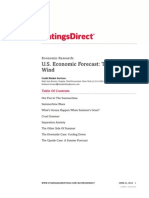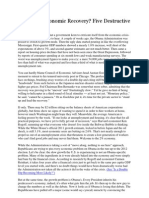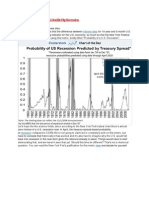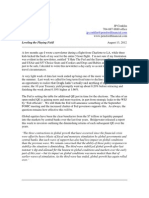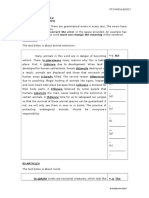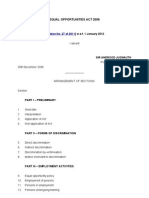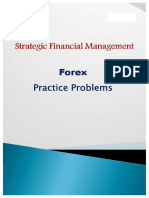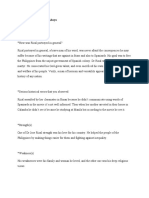A. Gary Shilling's: Insight
A. Gary Shilling's: Insight
Uploaded by
streettalk700Copyright:
Available Formats
A. Gary Shilling's: Insight
A. Gary Shilling's: Insight
Uploaded by
streettalk700Original Title
Copyright
Available Formats
Share this document
Did you find this document useful?
Is this content inappropriate?
Copyright:
Available Formats
A. Gary Shilling's: Insight
A. Gary Shilling's: Insight
Uploaded by
streettalk700Copyright:
Available Formats
A.
Gary Shilling�s INSIGHT
Economic Research and Investment Strategy Volume XXX, Number 4 April 2014
In This Issue
The Fed Capitulates�And For Good Reason The Fed junked its 6.5% unemployment rate target for raising interest rates largely because the declining labor participation rate has artificially depressed joblessness. About 60% of the participation rate drop from its 2000 peak is due to demographics, principally the retiring postwar babies. Forty percent of the decline is due to youths who stayed in school due to poor job prospects. Middle-aged discouraged workers also dropped out but were offset by the rising number of 65+ people who work due to inadequate retirement funds as well as better health. The overall participation rate dropped from 67.4% of those age 16+ in 2000 to 63% this year, and current trends will push it to 60.1% in 2020. Even at the low level, population growth will provide enough people to accommodate the return to rapid economic growth, assuring the proper skill matches and productivity growth at the 2000s rate. How China's Woes Could Shock Investors The ongoing "risk on" investment climate would shift to "risk off" with a substantial shock. Difficulties in China may result in such a jolt, and 8 problems there point in that direction: 1.Slowing Economic Growth 2.Transition from Export-Led to DomesticDriven Economy 3.Rising Militarism 4.Anti-Corruption Campaign 5.Manipulation of the Yuan 6.Shadow Banking Risks 7.Interest Rate Deregulation 8.Botched Bailouts
The Fed Capitulates�And For Good Reason
The Federal Reserve finally threw in the towel on its unfortunate target�the 6.5% unemployment rate (Chart 1) at which it would likely raise the federal funds rate in controls from essentially zero at present. �Unfortunate� We say �unfortunate� for two reasons. First, setting quantitative targets is ridiculous in an era when monetary policy is subject to fiscal drag due to higher income tax rates and the expiration of 2009's massive stimuli, uncertain consumer spending, a skittish housing sector, Congressional gridlock and the unknown effects of foreign developments such as slowing growth and
CHART 1 Alternative Measures of Unemployment
Last Points 2/14: unempl. 6.7%; alt. measure 12.6%
18% 16% 14% 12% 10% 8% 6% 4% 2% Jan-00 18% 16% 14% 12% 10% 8% 6% 4% 2% Jan-14
Jan-02 Jan-04 Jan-06 Total unemployed (U-3)
Jan-08
Jan-10
Jan-12
Total unemployed + marginally attached workers + employed part time for economic reasons (U-6)
Source: Bureau of Labor Statistics
Now you can follow Gary Shilling on Twitter @agaryshilling
INSIGHT (ISSN 0899-6393) goes to press by the third business day of the month. 2014 A. Gary Shilling & Co., Inc., 500 Morris Avenue, Springfield, NJ 07081-1020. Telephone: 973-467-0070. Fax: 973-467-1943. E-mail: insight@agaryshilling.com. Web: www.agaryshilling.com. President: A. Gary Shilling. Editor and Publisher: Fred T. Rossi. Research Associates: Colin Hatton and Tea Gongadze. All rights reserved. No part of this publication may be reproduced or redistributed without the written permission of A. Gary Shilling & Co. Material contained in this report is based upon information we consider reliable. The accuracy or completeness is not guaranteed and should not be relied upon as such. This is not a solicitation of any order to buy or sell. A. Gary Shilling & Co., Inc., its affiliates or its directors and employees may from time to time have a long or short position in any security, option or futures contract of the issue(s) mentioned in this report.
April 20142014 February
A. Gary Shilling's INSIGHT
insight@agaryshilling.com
www.agaryshilling.com
financial problems in China and other developing economies. After the meltdown of the subprime mortgage market revealed its opaqueness, transparency became the goal in Washington and in financial markets. Federal Reserve officials, as mere mortals, caught the bug and have tried to apply transparency to their policy targets even though monetary goals are driven by uncertain data and therefore impossible to quantify with any degree of precision. Even if monetary goals could be precisely and predictably delineated, doing so would remove the uncertainty and mystery from policy. And that unpredictability is what keeps markets honest and speculation in check. Consider the Chinese yuan, which was raised vs. the dollar so steadily in recent years that speculators jumped in to take advantage of a one-way bet, often moving money into China illegally to do so. That induced the government to depreciate the yuan, starting in mid-February, to create uncertainty and punish speculators but with as yet unknown unintended and possibly destabilizing consequences. A Poor Indicator The second reason the Fed's unemployment rate goal was unfortunate is because even though this is the headline number, it is a notoriously poor indicator of labor market conditions. It�s the ratio of the jobless, those who say they�ve actively looked for work in the last four weeks, to the sum of that group and the employed. So it doesn�t account for the quality of jobs. As we�ve noted in past Insights, leisure and hospitality jobs have risen by 1.53 million since the trough in January 2010 while manufacturing jobs have climbed 622,000 since their February 2010 bottom. But since leisure and hospitality workers are paid less and work fewer hours than in manufacturing, their weekly pay is only 35% as large. Furthermore, the headline unemployment rate�U-3 in Bureau of Labor Statistics parlance (Chart 1)� doesn�t say anything about the leap in the Great Recession in the long-term unemployed (Chart 2) or the widened unemployment rate gaps based on race
2 A. Gary Shilling's INSIGHT
and education levels. Ditto for the leap in part-time employees who would like to work full-time (part-time for economic reasons). And, of course, the standard unemployment rate does not measure the ongoing income polarization in America, which we discussed in detail last month, and the drop in median real income, even in the ongoing economic recovery. Labor Participation Rate Most importantly, the headline unemployment rate doesn�t account for the hordes who have dropped out of the labor force and therefore aren�t counted as unemployed. As discussed in detail in �How Tight Are Labor Markets?� (June 2013 Insight), if the labor participation rate now were the same as the 67.3% in February 2000, the labor force would be 10.6 million bigger than it is. Since the unemployment rate back then was 4.1%, this implies 14.3 million more job holders. Without that decline and with today � s employment, the U-3 unemployment rate would be 12.7%. Furthermore, 88% of the decline in the jobless rate since its peak at 10% in October 2009 was linked to the drop in the participation rate from 65.0% back then to 63.0% in February 2014.......
(You can read the full report by subscribing to Gary Shilling's INSIGHT. Call us at 1-888-346-7444 or 973-467-0070 to sign up today!)
CHART 2 Duration of Unemployment
Last Points 2/14: 27+ weeks 37.0%; avg. weeks 37.1
50% 45% 40% 35 35% 30% 25% 20% 15% 15 10% 5% 0% Jan-48 10 5 Jan-58 Jan-68 Jan-78 Jan-88 Jan-98 Jan-08 30 25 20 45 40
% Unemployed for 27+ Weeks as a % of Total - left axis Avg. Weeks Unemployed - right axis
Source: Bureau of Labor Statistics
April 2014
insight@agaryshilling.com
www.agaryshilling.com
How China's Woes Could Shock Investors
In last month�s Insight, we noted that the �risk on� investment climate persists with robust U.S. equities even though �Consumer spending is subdued, even after accounting for inclement weather early this year �The housing recovery is slipping and has been driven by rentals, not the solid foundation of new homeowners �The Administration�s fixation on income redistribution reinforces gridlock in Washington as the 2014 elections loom �Tepid labor markets have weakened further and the weather isn�t to blame �Obama�s minimum wage proposal will cut employment by 500,000 while adding a trivial net $2 billion to incomes, according to the CBO �While Obamacare confuses individuals and employers alike, the CBO forecasts a 2.5 million job loss as people are paid to not work �The Fed is determined to taper despite deflation risks, falling commodity prices and emerging market crises �Reduced Fed largess is separating the well-managed developing country Sheep from the poorly-run Goats while global contagion remains a possibility �The crisis in Ukraine threatens a slowdown in East-West trade and a revival of the Cold War Shocks This month, we�ll begin to examine the many shocks that would force investors into an agonizing reappraisal and a switch to a �risk off� strategy. Most investors with long-only equity portfolios don�t want to walk away from a winning game. Like most humans, they play until they lose, as was true of the dot com stocks in the late 1990s (Chart 1) and the housing bubbledriven market in the mid-2000s (Chart 2). They prefer to ignore the removal of fuel under the boiling equity pot provided by the Fed since August 2008. They also turn a blind eye to the basis of corporate earnings: the unsustainable leap in profit margins driven by costcutting (Chart 3) and the lack of solid sales volume gains in a slow growth economy and the absence of pricing power in an inflation-less business climate. It�s possible, of course, that equity investors� enthusiasm will be vindicated. All the problems we just listed may be solved without significant stock market implications. Economic growth may spurt this year and fulfill expectations even though similar hopes in each of the last five years have been dashed. But
April 2014
5500 5000 4500 4000 3500 3000 2500 2000 1500 1000 500 0 Jan-80 Dec-83 Nov-87 Nov-91 Oct-95 Oct-99 Oct-03 Sep-07 Sep-11
CHART 1 Nasdaq Index
Last Point 4/1/14: 4,268
5500 5000 4500 4000 3500 3000 2500 2000 1500 1000 500 0
Source: Yahoo Finance
CHART 2 S&P 500 Index
Last Point 4/1/14: 1,886
2000 1800 1600 1400 1200 1000 800 600 400 200 0 Jan-80 Dec-83 Nov-87 Nov-91 Oct-95 Oct-99 Oct-03 Sep-07 Sep-11 2000 1800 1600 1400 1200 1000 800 600 400 200 0
Source: Yahoo Finance
A. Gary Shilling's INSIGHT
insight@agaryshilling.com
www.agaryshilling.com
absent these salutary developments, the ongoing � risk on � euphoria will probably be ended by a significant shock. Last month, we listed five potential major shocks: A financial crisis in China if she bungles her attempts to shift from an export-driven to a domesticled economy while opening financial markets; an escalating confrontation between Russia and the West over Ukraine and nearby countries; a spike in oil prices resulting from a blow-up in the Middle East or in Venezuela; and global contagion resulting from developing country woes. We�re not forecasting one or more of these shocks to materialize. Nevertheless, in a slow growth world, they can�t be ignored since it doesn�t take much of a hiccup to turn meager growth into a self-feeding decline in economic activity. Also, the number of possible shocks is important since one can trigger others, just as the subprime residential mortgage collapse, starting in early 2007, spread to Wall Street quickly and required massive financial rescue to avoid a meltdown.
CHART 3 Corporate Profits and Employee Compensation
as a % of national income
Last Points 4Q 2013: corp. profits 14.7%; employee comp. 60.7%
68% 67% 66% 13% 65% 64% 63% 62% 61% 9% 60% 59% 58% 1947-I 8% 7% 1959-III 1972-I 1984-III 1997-I 2009-III Compensation of Employees - left axis Corp. Profits with IVA and CCAdj - right axis 12% 11% 10% 15% 14%
Source: Bureau of Economic Analysis
CHART 4 Problems In China
1. 2. 3. 4. 5. 6. 7. 8.
Slowing Economic Growth Transition from Export-Led to Domestic-Driven Economy Rising Militarism Anti-Corruption Campaign Manipulation of the Yuan Shadow Banking Risks Interest Rate Deregulation Botched Bailouts
Even if all of these shocks are independent of the others and each has only a 20% likelihood, the statistical probability that one or more of them will unfold is 67%! This month, we�ll concentrate on China, and then examine the other shocks in the future. China has vaulted to become the second largest economy worldwide. She�s the 800-lb. gorilla among developing countries even though China is still an economy pigmy in terms of GDP per capita. Her global importance has been magnified in the last several decades as manufacturing shifted there from North America and Europe. So her imports of raw materials and exports of manufactured goods have exceeded greatly her internal demand. This means that China�s problems are the world�s problems, and there are eight of them that singly�or
4 A. Gary Shilling's INSIGHT
more likely, in combination�could precipitate a major crisis (Chart 4). Even if only one difficulty surfaces, it�s far from clear that it can be contained without leading to a full-blown crisis, despite the best efforts of Chinese leaders.......
(You can read the full report by subscribing to Gary Shilling's INSIGHT. Call us at 1-888-346-7444 or 973-467-0070 to sign up today!)
April 2014
You might also like
- Yoga Sculpt ScriptDocument31 pagesYoga Sculpt Scriptalan0% (1)
- Sample Service Record DepEdDocument1 pageSample Service Record DepEdBinday NationalHS100% (6)
- A. Gary Shilling's: InsightDocument33 pagesA. Gary Shilling's: InsightmattpaulsNo ratings yet
- 5 Reasons To Fear A US Double DipDocument5 pages5 Reasons To Fear A US Double DipbenclaremonNo ratings yet
- 2017-08 Some Speed Bumps Slowing The BullDocument4 pages2017-08 Some Speed Bumps Slowing The BullMichael BenzingerNo ratings yet
- Sprott 2013 P1 Ignoring The ObviousDocument7 pagesSprott 2013 P1 Ignoring The ObviouscasefortrilsNo ratings yet
- U.S. Economic Forecast: The Summer WindDocument13 pagesU.S. Economic Forecast: The Summer Windapi-227433089No ratings yet
- MFM Jul 8 2011Document14 pagesMFM Jul 8 2011timurrsNo ratings yet
- In The NewsDocument6 pagesIn The Newsapi-244981307No ratings yet
- Good News Is Bad News Once Again As Stronger Employment Growth Spooks MarketsDocument12 pagesGood News Is Bad News Once Again As Stronger Employment Growth Spooks Marketsjjy1234No ratings yet
- The Pensford Letter - 7.9.12Document5 pagesThe Pensford Letter - 7.9.12Pensford FinancialNo ratings yet
- Wien Byron - August 2010 Market CommentaryDocument3 pagesWien Byron - August 2010 Market CommentaryZerohedgeNo ratings yet
- Monthly Economic Outlook 06082011Document6 pagesMonthly Economic Outlook 06082011jws_listNo ratings yet
- Market Notes - June 6, 2011 - MondayDocument2 pagesMarket Notes - June 6, 2011 - MondayJC CalaycayNo ratings yet
- Byron Wien: Investment Outlook 3-3-2014Document4 pagesByron Wien: Investment Outlook 3-3-2014dpbasicNo ratings yet
- Gary Shilling Review and Forecast: Low Interest RatesDocument22 pagesGary Shilling Review and Forecast: Low Interest Ratesrichardck61No ratings yet
- What Is GDP?: Kimberly AmadeoDocument44 pagesWhat Is GDP?: Kimberly Amadeobhupenderkamra100% (1)
- U.S. Market Update August 12 2011Document6 pagesU.S. Market Update August 12 2011dpbasicNo ratings yet
- Weekly Economic Commentary 10-10-11Document8 pagesWeekly Economic Commentary 10-10-11monarchadvisorygroupNo ratings yet
- Atwel - Global Macro 6/2011Document15 pagesAtwel - Global Macro 6/2011Jan KaskaNo ratings yet
- 5 MythsDocument6 pages5 MythsParvesh KhuranaNo ratings yet
- Powell 20240823 ADocument20 pagesPowell 20240823 AZerohedgeNo ratings yet
- S&P (Global Ratings) - Daily Update Looking at The US Labor MarketDocument16 pagesS&P (Global Ratings) - Daily Update Looking at The US Labor MarketCalvin YeohNo ratings yet
- GDP Growth SlowsDocument2 pagesGDP Growth SlowsPavelNo ratings yet
- U.S. Economic Forecast: Gale WarningDocument9 pagesU.S. Economic Forecast: Gale Warningapi-227433089No ratings yet
- Weekly Economic Update - 6!6!14Document2 pagesWeekly Economic Update - 6!6!14Anonymous Feglbx5No ratings yet
- Kinnaras Capital Management LLC: July 2010 Market CommentaryDocument4 pagesKinnaras Capital Management LLC: July 2010 Market Commentaryamit.chokshi2353No ratings yet
- Chart: Zero Chance of A U.S. Double Dip Recession: Business InsiderDocument9 pagesChart: Zero Chance of A U.S. Double Dip Recession: Business InsiderChirag AbrolNo ratings yet
- Spyglass Macro 08aug22Document13 pagesSpyglass Macro 08aug22Ronan CurranNo ratings yet
- Buy HODL in May and Walk AwayDocument19 pagesBuy HODL in May and Walk Awaydiogo_chaves_francoNo ratings yet
- US rate cuts impactDocument2 pagesUS rate cuts impactVishesh DaveNo ratings yet
- Mike Astrachan - Employment Is Rising Fast. Can It Make Economic Growth Self-Sustaining and Can The Stock Market Follow?Document4 pagesMike Astrachan - Employment Is Rising Fast. Can It Make Economic Growth Self-Sustaining and Can The Stock Market Follow?ShlomiNo ratings yet
- Yellen Speech 7.10Document15 pagesYellen Speech 7.10ZerohedgeNo ratings yet
- The Great American Non-RecoveryDocument10 pagesThe Great American Non-Recoverystreettalk700No ratings yet
- Outlook 2012 - Raymond JamesDocument2 pagesOutlook 2012 - Raymond JamesbubbleuppNo ratings yet
- The Fed Perturbs The MarketsDocument2 pagesThe Fed Perturbs The MarketsDoug PotashNo ratings yet
- Jul 16 Erste Group Macro Markets UsaDocument6 pagesJul 16 Erste Group Macro Markets UsaMiir ViirNo ratings yet
- The Recovery of The US Labor Market in Line With The Medium RunDocument7 pagesThe Recovery of The US Labor Market in Line With The Medium RunBrenda MacarthyNo ratings yet
- Outlook 2014Document27 pagesOutlook 2014ttboy39No ratings yet
- 1 10 UpdateDocument3 pages1 10 Updatenatdogg1No ratings yet
- American: Memorandum (SAMPLE ONLY)Document8 pagesAmerican: Memorandum (SAMPLE ONLY)testtest1No ratings yet
- A Time For Caution in Global Markets?Document3 pagesA Time For Caution in Global Markets?tera.secret santaNo ratings yet
- The Credit Cloud: U.S. Consumer Sectors Could Suffer As The Population AgesDocument10 pagesThe Credit Cloud: U.S. Consumer Sectors Could Suffer As The Population Agesapi-227433089No ratings yet
- JPM Market ReportDocument3 pagesJPM Market ReportDennis OhlssonNo ratings yet
- Lutho QobaDocument8 pagesLutho QobaLutho Soso001No ratings yet
- Federal Reserve Bank of San FranciscoDocument7 pagesFederal Reserve Bank of San FranciscoMargaret CanfieldNo ratings yet
- Spex Issue 29Document11 pagesSpex Issue 29SMU Political-Economics Exchange (SPEX)No ratings yet
- Powell 20210210 ADocument20 pagesPowell 20210210 AZerohedgeNo ratings yet
- Lookout Report: The U.S. March Employment Report Was Not Weak, Just DisappointingDocument22 pagesLookout Report: The U.S. March Employment Report Was Not Weak, Just DisappointingBao NguyenNo ratings yet
- February 2014Document6 pagesFebruary 2014Center for American ProgressNo ratings yet
- How Unemployment Rates Affect The EconomyDocument2 pagesHow Unemployment Rates Affect The EconomyaimanNo ratings yet
- 1 Sdkasflksa LFKD'K'Document10 pages1 Sdkasflksa LFKD'K'tilakdatta.iyer19No ratings yet
- Van Hoisington Letter, Q3 2011Document5 pagesVan Hoisington Letter, Q3 2011Elliott WaveNo ratings yet
- America's Lost DecadeDocument10 pagesAmerica's Lost DecadeFrode HaukenesNo ratings yet
- Hoisington Q4Document6 pagesHoisington Q4ZerohedgeNo ratings yet
- The Pensford Letter - 10.1.12Document4 pagesThe Pensford Letter - 10.1.12Pensford FinancialNo ratings yet
- Pension Fund Crisis in UsaDocument5 pagesPension Fund Crisis in UsaHa PhamNo ratings yet
- The Global Outlook Isn't Bad. But When Will It Be Good?Document6 pagesThe Global Outlook Isn't Bad. But When Will It Be Good?api-227433089No ratings yet
- Economist Insights: The Employment EnigmaDocument2 pagesEconomist Insights: The Employment EnigmabuyanalystlondonNo ratings yet
- The Pensford Letter - 8.13.12Document5 pagesThe Pensford Letter - 8.13.12Pensford FinancialNo ratings yet
- 2012: THE WEAK ECONOMY AND HOW TO DEAL WITH IT TO EMPOWER THE CITIZENSFrom Everand2012: THE WEAK ECONOMY AND HOW TO DEAL WITH IT TO EMPOWER THE CITIZENSNo ratings yet
- 2015: Outlook for Stocks, Bonds, Commodities, Currencies and Real EstateFrom Everand2015: Outlook for Stocks, Bonds, Commodities, Currencies and Real EstateNo ratings yet
- AroundTheWorldIn8Pages Q1 2019 LVDocument41 pagesAroundTheWorldIn8Pages Q1 2019 LVstreettalk700No ratings yet
- GTA Introduction RIA ProDocument7 pagesGTA Introduction RIA Prostreettalk700100% (2)
- Investor Intelligence Techical Analysis GuideDocument25 pagesInvestor Intelligence Techical Analysis Guidestreettalk700No ratings yet
- Greg Morris - 2017 Economic & Investment Summit Presentation - Questionable PracticesDocument53 pagesGreg Morris - 2017 Economic & Investment Summit Presentation - Questionable Practicesstreettalk700No ratings yet
- Summer Market Outlook & ForecastDocument51 pagesSummer Market Outlook & Forecaststreettalk700No ratings yet
- Unconventional Policies and Their Effects On Financial Markets PDFDocument36 pagesUnconventional Policies and Their Effects On Financial Markets PDFSoberLookNo ratings yet
- SP500 ValuationDocument14 pagesSP500 Valuationstreettalk700No ratings yet
- Psychology of Risk-Behavioral Finance PerspectiveDocument28 pagesPsychology of Risk-Behavioral Finance Perspectivestreettalk700No ratings yet
- Value Investor Forum Presentation 2015 (Print Version)Document29 pagesValue Investor Forum Presentation 2015 (Print Version)streettalk700No ratings yet
- EmpDocument6 pagesEmpdpbasicNo ratings yet
- Companies Paying Dividend SP500 - 2007-2015Document8 pagesCompanies Paying Dividend SP500 - 2007-2015streettalk700No ratings yet
- Valuations Suggest Extremely Overvalued MarketDocument9 pagesValuations Suggest Extremely Overvalued Marketstreettalk700No ratings yet
- Cycles and Possible OutcomesDocument6 pagesCycles and Possible Outcomesstreettalk700No ratings yet
- Lacy Hunt - Hoisington - Quartely Review Q1 2014Document5 pagesLacy Hunt - Hoisington - Quartely Review Q1 2014TREND_7425No ratings yet
- X-Factor Report 1/28/13 - Will The Market Ever Correct?Document10 pagesX-Factor Report 1/28/13 - Will The Market Ever Correct?streettalk700No ratings yet
- The Great American Non-RecoveryDocument10 pagesThe Great American Non-Recoverystreettalk700No ratings yet
- Companies Paying Dividend SP500 - 2007-2015Document8 pagesCompanies Paying Dividend SP500 - 2007-2015streettalk700No ratings yet
- Understanding The Bear CaseDocument17 pagesUnderstanding The Bear Casestreettalk700No ratings yet
- Personal Finance Webinar Presentation 11/12/2012 Streettalk AdvsiorsDocument19 pagesPersonal Finance Webinar Presentation 11/12/2012 Streettalk Advsiorsstreettalk700No ratings yet
- GMO Capital Q4 2012 LetterDocument14 pagesGMO Capital Q4 2012 LetterWall Street WanderlustNo ratings yet
- Is US Economic Growth OverDocument25 pagesIs US Economic Growth Overstreettalk700No ratings yet
- A Comparison of The Real-Time Performance of Business Cycle Dating MethodsDocument28 pagesA Comparison of The Real-Time Performance of Business Cycle Dating MethodscaitlynharveyNo ratings yet
- Is US Economic Growth OverDocument25 pagesIs US Economic Growth Overstreettalk700No ratings yet
- DeindustrilizationDocument22 pagesDeindustrilizationeugeNo ratings yet
- Camouco (Panama vs. France)Document4 pagesCamouco (Panama vs. France)Je S BeNo ratings yet
- Rosli DhobyDocument4 pagesRosli Dhobycikliey28No ratings yet
- Pay SlipZH - 0803ZH0008Document2 pagesPay SlipZH - 0803ZH0008NaveenNaveNo ratings yet
- Bill Ryan - Making Capital From CultureDocument304 pagesBill Ryan - Making Capital From CultureJoaquim RiusNo ratings yet
- Absenteeism All ChaptersDocument14 pagesAbsenteeism All ChaptersSildjhann OgamaNo ratings yet
- The Geography of Cinema - A Cinematic WorldDocument204 pagesThe Geography of Cinema - A Cinematic WorldAlejandra Maria Ruiz RubianoNo ratings yet
- Adobe Scan 12 Nov 2020Document7 pagesAdobe Scan 12 Nov 2020Heavy DutyNo ratings yet
- Module q1 English Pt3 WeakDocument5 pagesModule q1 English Pt3 WeakZeti Akhtar AdnanNo ratings yet
- ثنائية الاقتصاد والسياسة في فلسفة كارل ماركسDocument14 pagesثنائية الاقتصاد والسياسة في فلسفة كارل ماركسraki nadiraNo ratings yet
- Badminton MechanicsDocument2 pagesBadminton Mechanicsmharyjhanemantileg14No ratings yet
- Equal Opportunities Act 2008Document45 pagesEqual Opportunities Act 2008Yuvraj KeenooNo ratings yet
- Roro Jonggrang Kel 1Document3 pagesRoro Jonggrang Kel 1Heksa kynantiNo ratings yet
- CPJ2 RSClarkDocument19 pagesCPJ2 RSClarkmount2011No ratings yet
- Forex Handout - 1 With AnswersDocument34 pagesForex Handout - 1 With AnswersPriyanka100% (1)
- CRPC P PDFDocument20 pagesCRPC P PDFsai kiran gudisevaNo ratings yet
- Mines Merit List 1Document3 pagesMines Merit List 1Rasheed ShahwaniNo ratings yet
- INTASAM, Northumbria Interview Sheets Prepared by AADocument25 pagesINTASAM, Northumbria Interview Sheets Prepared by AAintasamahad2003No ratings yet
- Soal Lks It Networking Support 20121Document5 pagesSoal Lks It Networking Support 20121Hendi RuhandiNo ratings yet
- English 10 - Quarter 1 - Performance Task 2Document1 pageEnglish 10 - Quarter 1 - Performance Task 2Carlo Fernando100% (2)
- AHIST 1401-01 - AY2022-T4 - Web Resources For Art History ResearchDocument3 pagesAHIST 1401-01 - AY2022-T4 - Web Resources For Art History ResearchAhmed Al-BetarNo ratings yet
- Kelly Wright hw499 ResumeDocument2 pagesKelly Wright hw499 Resumeapi-526258935No ratings yet
- SS4Document110 pagesSS4Anam JunaidNo ratings yet
- MIRO Table - SapDocument1 pageMIRO Table - SapKaran MathurNo ratings yet
- I. Director Marilou Diaz Abaya Actor Cesar MontanoDocument8 pagesI. Director Marilou Diaz Abaya Actor Cesar MontanoElle's CrazinessNo ratings yet
- Contoh Carta OrganisasiDocument1 pageContoh Carta OrganisasiTun ImranNo ratings yet
- Rent Receipt Generator Online - Generate House Rent ReceiptDocument4 pagesRent Receipt Generator Online - Generate House Rent ReceiptTARUNNo ratings yet






